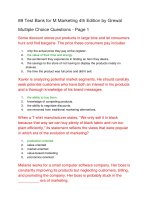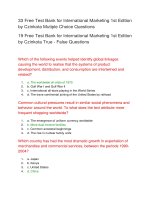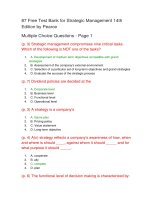Test bank for technology for diagnostic sonography 1st edition by hedrick
Bạn đang xem bản rút gọn của tài liệu. Xem và tải ngay bản đầy đủ của tài liệu tại đây (73.04 KB, 7 trang )
buy this full document at
Hedrick: Technology for Diagnostic Sonography
Chapter 1: Properties of Sound Waves
Test Bank
MULTIPLE CHOICE
1. What is the wavelength in soft tissue for a 10-MHz ultrasonic wave?
a. 0.15 cm
c. 0.30 cm
b. 0.15 mm
d. 0.30 mm
ANS: B
Determined by the relationship between acoustic velocity, frequency, and wavelength
PTS: 1
REF: 6
OBJ: Know the relationship between acoustic velocity, frequency, and wavelength.
TOP: Properties of sound waves
2. What is the wavelength in fat for a 5-MHz ultrasonic wave?
a. 0.14 cm
c. 0.29 cm
b. 0.14 mm
d. 0.29 mm
ANS: D
Determined by the relationship between acoustic velocity, frequency, and wavelength
PTS: 1
REF: 6
OBJ: Know the relationship between acoustic velocity, frequency, and wavelength.
TOP: Properties of sound waves
3. What is the period for a 5-MHz ultrasonic wave?
a. 0.2 ns
c. 0.2 ms
b. 0.2 s
d. 0.2 s
ANS: B
Determined by the relationship between frequency and period
PTS: 1
REF: 4
OBJ: Know the relationship between frequency and period. TOP: Properties of sound
waves
4. What is the period for a 10-MHz ultrasonic wave?
a. 0.10 s
c. 0.20 s
b. 0.15 s
d. 0.30 s
ANS: A
buy this full document at
Full file at />Determined by the relationship between frequency and period
PTS: 1
REF: 4
OBJ: Know the relationship between frequency and period. TOP: Properties of sound
waves
5. What term describes the region of increased molecular density induced by sound
propagation in a medium?
a. Compression
c. Fresnel
b. Focal
d. Rarefaction
ANS: A
Pressure variations produce alternating regions of high and low particle density.
PTS: 1
REF: 1-2
TOP: Properties of sound waves
6. What is the compression zone?
a. Region of high particle density
b. Region of low particle density
OBJ: Describe the propagation of sound.
c. Region of high acoustic impedance
d. Region of low acoustic impedance
ANS: A
Pressure variations produce alternating regions of high and low particle density.
PTS: 1
REF: 1-2
TOP: Properties of sound waves
OBJ: Describe the propagation of sound.
7. What term describes the region of decreased molecular density induced by sound
propagation in a medium?
a. Compression
c. Fresnel
b. Focal
d. Rarefaction
ANS: D
Pressure variations produce alternating regions of high and low particle density.
PTS: 1
REF: 1-2
TOP: Properties of sound waves
8. What is the rarefaction zone?
a. Region of high particle density
b. Region of low particle density
OBJ: Describe the propagation of sound.
c. Region of high acoustic impedance
d. Region of low acoustic impedance
ANS: B
Pressure variations produce alternating regions of high and low particle density.
PTS: 1
REF: 1-2
OBJ: Describe the propagation of sound.
Copyright © 2013 by Mosby, an imprint of Elsevier Inc.
Full file at />TOP: Properties of sound waves
9. What term describes the number of pressure oscillations per unit of time?
a. Acoustic velocity
c. Period
b. Frequency
d. Wavelength
ANS: B
Definition of frequency
PTS: 1
REF: 4
TOP: Properties of sound waves
OBJ: Know the definition of frequency.
10. What term describes the distance between compression zones?
a. Acoustic velocity
c. Period
b. Frequency
d. Wavelength
ANS: D
Definition of wavelength.
PTS: 1
REF: 3
TOP: Properties of sound waves
OBJ: Know the definition of wavelength.
11. What term describes the distance of one cycle for a wave?
a. Acoustic velocity
c. Period
b. Frequency
d. Wavelength
ANS: D
Definition of wavelength.
PTS: 1
REF: 3
TOP: Properties of sound waves
OBJ: Know the definition of wavelength.
12. What is the frequency for the ultrasound wave, which has a wavelength of 0.20 mm in
soft tissue?
a. 10 MHz
c. 6 MHz
b. 7.5 MHz
d. 3.5 MHz
ANS: B
Determined by the relationship between acoustic velocity, frequency, and wavelength
PTS: 1
REF: 6
OBJ: Know the relationship between acoustic velocity, frequency, and wavelength.
TOP: Properties of sound waves
13. Which material has the lowest acoustic velocity?
a. Bone
c. Muscle
Copyright © 2013 by Mosby, an imprint of Elsevier Inc.
Full file at />b. Fat
d. Air
ANS: D
Determined by the bulk modulus and density of the medium
PTS: 1
REF: 6
materials.
TOP: Properties of sound waves
OBJ: Know the relative velocity for various
14. In which material does a 10-MHz sound wave have the longest wavelength?
a. Bone
c. Muscle
b. Fat
d. Air
ANS: A
Material with the greatest acoustic velocity has the longest wavelength.
PTS: 1
REF: 6
OBJ: Know the relationship between acoustic velocity, frequency, and wavelength.
TOP: Properties of sound waves
15. What is the period of an ultrasound wave whose frequency is 5 MHz?
a. 0.002 s
c. 3.1 x 10-4 s
6
b. 5 x 10 s
d. 2.0 x 10-7 s
ANS: D
Determined by the relationship between frequency and period
PTS: 1
REF: 4
OBJ: Know the relationship between frequency and period. TOP: Properties of sound
waves
16. Which factor affects the acoustic velocity in a medium?
a. Density of the medium
b. Cross-sectional area of ultrasound beam
c. Wavelength
d. Frequency
ANS: A
Acoustic velocity is determined by the bulk modulus and density of the medium.
PTS: 1
REF: 5
velocity.
TOP: Properties of sound waves
OBJ: Identify the factors that affect acoustic
17. What characterizes the elasticity of a medium?
a. Fractional change is shape from an applied force
Copyright © 2013 by Mosby, an imprint of Elsevier Inc.
Full file at />b. Return to original shape after removal of applied force
c. High particle velocity during propagation
d. Low particle velocity during propagation
ANS: B
Elasticity describes the ability of a medium to return to its original shape when a force is
removed.
PTS: 1
REF: 5
TOP: Properties of sound waves
OBJ: Describe the propagation of sound.
18. What denotes a longitudinal wave?
a. Particle motion is along the direction of propagation
b. Particle motion is perpendicular to the direction of propagation
c. Wavelength over 1 mm
d. Wavelength over 1 cm
ANS: A
Attribute of longitudinal wave
PTS: 1
REF: 3
TOP: Properties of sound waves
OBJ: Describe the propagation of sound.
19. What describes a transverse wave?
a. Particle motion is along the direction of propagation
b. Particle motion is perpendicular to the direction of propagation.
c. Long wavelength over 1 mm
d. Long wavelength over 1 cm
ANS: B
Attribute of transverse wave
PTS: 1
REF: 3
TOP: Properties of sound waves
OBJ: Describe the propagation of sound.
20. Which type of wave exhibits particle motion along the direction of propagation?
a. Longitudinal
c. Transverse
b. Sheer
d. Light
ANS: A
Attribute of longitudinal wave
PTS: 1
REF: 3
TOP: Properties of sound waves
OBJ: Describe the propagation of sound.
21. What term describes the rate of flow of energy over a small area?
Copyright © 2013 by Mosby, an imprint of Elsevier Inc.
Full file at />a. Compression
b. Intensity
c. Pressure
d. Frequency
ANS: B
Intensity describes the transmittal of energy by the sound wave.
PTS: 1
REF: 5
TOP: Properties of sound waves
22. What are the units for intensity?
a. J/s
b. m/s
OBJ: Describe the propagation of sound.
c. Nt/cm2
d. mW/cm2
ANS: D
Intensity has units of energy per time (mW) per area (cm2).
PTS: 1
REF: 5
TOP: Properties of sound waves
OBJ: Know the definition of intensity.
23. What is the period for the ultrasound wave, which has a wavelength of 0.20 mm in soft
tissue?
a. 0.10 s
c. 0.20 s
b. 0.13 s
d. 0.24 s
ANS: B
Calculate frequency using the acoustic velocity in tissue and take the reciprocal to
determine the period.
PTS: 1
REF: 4
OBJ: Know the relationship between frequency and period. TOP: Properties of sound
waves
24. What is the frequency range for human hearing?
a. 20 to 20,000 Hz
c. 20 to 1500 Hz
b. 20 to 20,000 kHz
d. 20 to 1500 kHz
ANS: A
The frequency range for human hearing is 20 to 20,000 Hz.
PTS: 1
REF: 3
hearing.
TOP: Properties of sound waves
OBJ: Know the frequency range for human
25. What is the lower frequency limit for ultrasound?
a. 20 Hz
c. 2000 Hz
b. 200 Hz
d. 20,000 Hz
Copyright © 2013 by Mosby, an imprint of Elsevier Inc.
Full file at />ANS: D
Ultrasound is sound with a frequency above 20,000 Hz.
PTS: 1
REF: 3
TOP: Properties of sound waves
OBJ: Know the frequency range for ultrasound.
26. Which acoustic variable is equal to acoustic velocity divided by the frequency?
a. Intensity
c. Period
b. Pressure
d. Wavelength
ANS: D
The acoustic velocity and frequency establish the wavelength via c = f.
PTS: 1
REF: 6
OBJ: Know the relationship between acoustic velocity, wavelength, and frequency.
TOP: Properties of sound waves
27. Which acoustic variable is equal to acoustic velocity divided by the wavelength?
a. Intensity
c. Frequency
b. Pressure
d. Period
ANS: C
The acoustic velocity and wavelength establish the frequency via c=fλ.
PTS: 1
REF: 6
OBJ: Know the relationship between acoustic velocity, wavelength, and frequency.
TOP: Properties of sound waves
28. Which medium type is likely to have the slowest acoustic velocity?
a. Gas
c. Tissue
b. Liquid
d. Metal
ANS: A
The low density and high compressibility of gas create slow sound transmission.
PTS: 1
REF: 6
OBJ: Know the characteristics of the medium determine the acoustic velocity.
TOP: Properties of sound waves
Copyright © 2013 by Mosby, an imprint of Elsevier Inc.









